A Preview of Visible Biology: From the Big Picture to the Molecular Level
Posted on 8/27/21 by Laura Snider
[Update: All of Visible Body's biology content is now exclusively available in VB Suite!]
An exciting new feature (Flashcards!) just released for the Web Suite and Courseware versions of Human Anatomy Atlas, but we’ve got even more cool content up our sleeve—specifically, a brand new product called Visible Biology. It’s in beta right now and we’re planning to release a full version early next year, but we’re so excited about it that we wanted to give you a sneak peek at what’s coming your way!
What kind of content will be in Visible Biology?
Let’s start by exploring the types of assets you’ll find in Visible Biology. It probably won’t surprise you to know that you’ll be seeing a new selection of 3D models like the ones in Visible Body’s other products. Instead of anatomical structures, you can zoom, rotate, and select models of plant, animal, and bacterial cells, DNA, prokaryotic and eukaryotic chromosomes, and the roots, stems, and leaves of monocot and dicot plants.
Because there are so many complex processes students need to know for their biology courses, we also have interactive 3D moving models! Their closest equivalent is the muscle action models in our other apps—you’ll notice that in the image below, there’s a slider that allows you to pause and manipulate the animation of the moving model. With these models, students will be able to visualize photosynthesis, cellular respiration, mitosis, and DNA coiling and supercoiling.
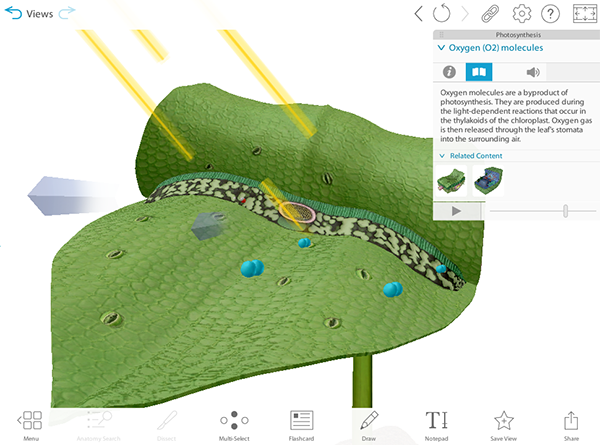
Oxygen molecules (highlighted) leaving a plant’s leaf during photosynthesis. Screenshot from Visible Biology (beta).
To round out students’ understanding, Visible Biology also contains animations that show these processes, as well as transcription and translation, in even greater detail.
Exploring a unit in Visible Biology
Visible Biology was created with the goal of helping students understand topics that they often find difficult and to give teachers an easy-to-use tool to help them illustrate these concepts. Instructors have told us that DNA storage within chromosomes is one of those tough topics, so we’ll show you how the genetics unit in Visible Biology gives students the interactive resources they need to gain a better understanding of how DNA and chromosomes are structured.
From the home screen of Visible Biology, you can see all the different units and the assets they contain. To start, all you need to do is scroll down to the unit you want and select one of the assets to open it.
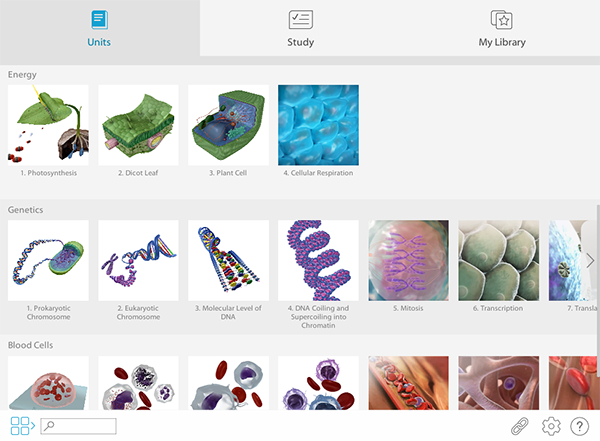
Several of the units available in Visible Biology. Screenshot from Visible Biology (beta).
The first models you’ll see in the genetics unit are the prokaryotic and eukaryotic chromosomes. By exploring these two 3D models, you can compare how DNA is stored in prokaryotic vs. eukaryotic cells.
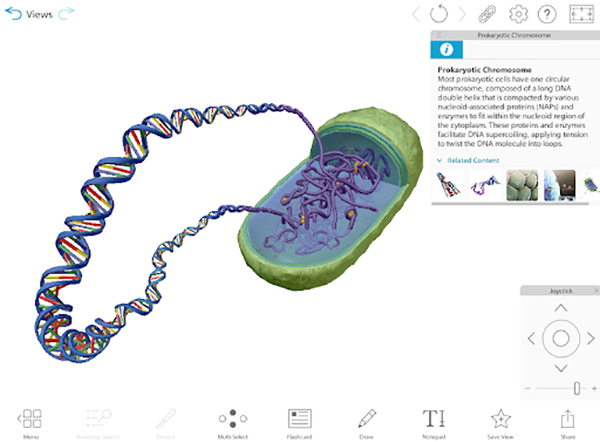
The prokaryotic chromosome, with description. Screenshot from Visible Biology (beta).
Just like eukaryotic chromosomes contain a lot of genetic information in a very small space, the eukaryotic chromosome model shows a lot of information in an easy-to-follow visual representation. Zoomed out, the eukaryotic chromosome model gives a big-picture view of the various levels of organization of DNA within the chromosome. Starting with the DNA double helix, composed of nitrogenous bases and a sugar-phosphate backbone, students can follow DNA as it coils around clusters of histone proteins to create nucleosomes, and then those connected nucleosomes form chromatin fibers, which continue to coil to form the chromosome itself.
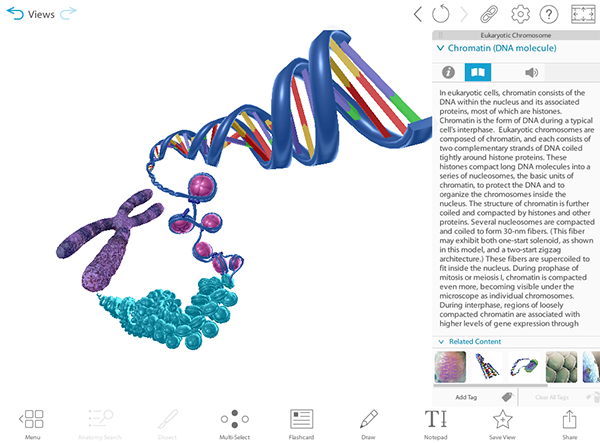
The eukaryotic chromosome model with chromatin level highlighted. Screenshot from Visible Biology (beta).
You can then go on to explore each of these levels individually with animated models. You can do this by returning to the main menu or by using the related content box, which allows you to move quickly between different models and views.
The molecular DNA model shows the base pairs and sugar phosphate backbone in detail, depicting the covalent bonds that connect the sugar molecules and phosphate groups as well as the hydrogen bonds that connect the nitrogenous bases in each base pair.
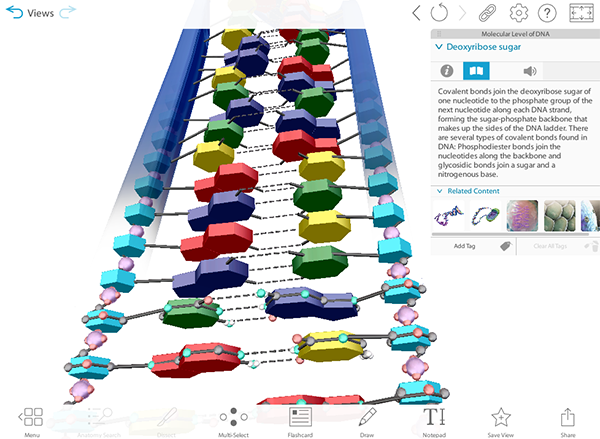
Molecular level of DNA with sugar molecules highlighted. Screenshot from Visible Biology (beta).
The DNA coiling animated model shows how DNA wraps two and a half times around a cluster of eight histone proteins to create a nucleosome. To see how chromatin fibers are formed by the coiling and supercoiling of DNA, check out the coiling and supercoiling moving model. You can pause the model’s movement or control its speed with the slider at the bottom of the info box. You can also select individual structures on the moving model to learn more about them.
The video below shows a preview of the DNA coiling and supercoiling moving models.
Connecting Visible Biology to your curriculum
Instructors, we’ve got good news for you: Visible Biology makes it quick and easy to use 3D models in your biology classroom! You can use the Study section to download free lab activities and lesson plans for each topic. Lesson plans include NGSS and Texas, California, and Florida state standards.
Visible Biology and Courseware
Want to create assignments and quizzes using content from Visible Biology and have everything all in one place? Visible Biology is coming to Courseware! This means that in addition to all the other apps available through Courseware (Human Anatomy Atlas, Anatomy & Physiology, Physiology & Pathology, Muscle Premium, and Physiology Animations), you’ll also get Visible Biology for the web. You’ll also get access to new biology-specific quizzes and questions in the quiz bank. Now you can teach the cells and genetics units in your A&P and biology courses in even greater detail.
Do you teach biology but not A&P? We’re planning to offer Visible Biology and our Anatomy & Physiology app in a streamlined Courseware package, which will give you all the content you need to teach an introductory biology course that includes human body systems.
Using Visible Biology to study
If you’re a student, we’ve got good news for you, too: you can review what you’ve learned by taking structure identification quizzes right in the app. All you have to do is go to the Study tab and select Quizzes, then choose the model you want to be quizzed on.
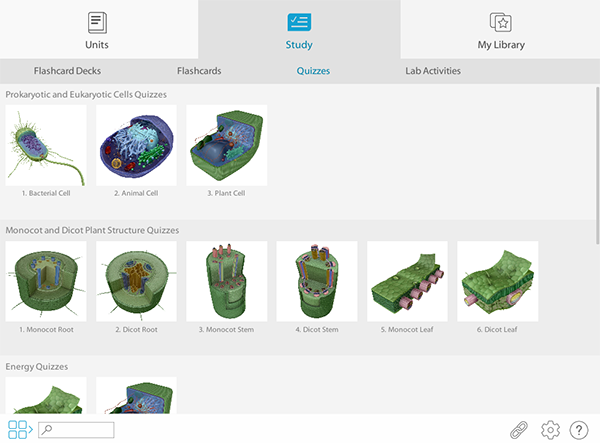
Several of the structure identification quizzes available in the Study section. Screenshot from Visible Biology (beta).
Also, we’re planning to add our new Flashcards feature (currently in Human Anatomy Atlas for Courseware and Web Suite) to the full release of Visible Biology for 2022! With Flashcards, you’ll be able to create decks of cards using Visible Body’s 3D models and share those decks with your classmates so you can study together.
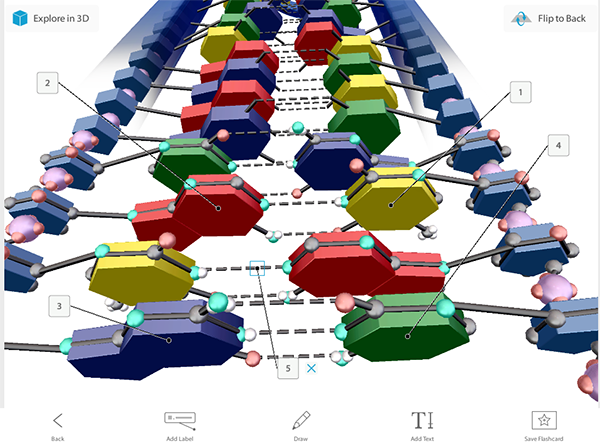
The front (question side) of a Flashcard with labels added for nitrogenous bases and hydrogen bond. Screenshot from Visible Biology (beta).
Want to learn more about Visible Biology? Contact our Sales Team for a demo! You can also sign up to receive email updates about the product.
Be sure to subscribe to the Visible Body Blog for more anatomy awesomeness!
Are you an instructor? We have award-winning 3D products and resources for your anatomy and physiology course! Learn more here.



